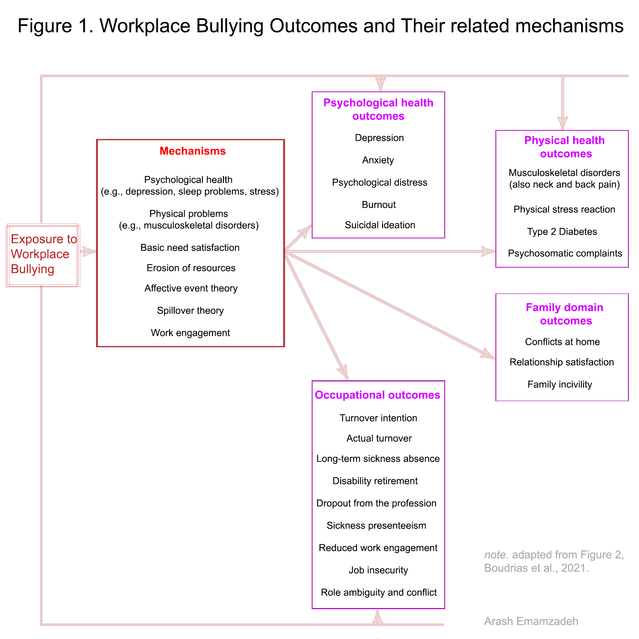Bullying
Workplace Bullying: Effects on Work, Health, and Family
The effects of workplace bullying are examined.
Posted April 22, 2021 Reviewed by Devon Frye
Key points
- Workplace bullying affects mental health (e.g., depression), physical health (e.g., tension), and family relationships (e.g., conflict).
- Mechanisms linking workplace bullying and negative outcomes include worse health, lack of need satisfaction, and reduced work engagement.
- Workplaces that identify and put a stop to workplace bullying may improve the mental and physical health of their staff.
Published in Aggression and Violent Behavior, new research by Boudrias and colleagues reviews the consequences and mechanisms of workplace bullying. Before summarizing the study, let's start by defining bullying.
What is Workplace Bullying?
Workplace mistreatment is prevalent. Many employees have experienced some form of workplace mistreatment—being insulted by a customer, harassed by a coworker, denied a promotion, etc.
How is workplace mistreatment different from bullying? For instance, is receiving an unfair performance evaluation an example of being bullied?
Workplace bullying occurs when:
- An employee becomes a target of adverse behavior regularly.
- The victim can neither easily avoid the situation nor the mistreatment.
- There is a power imbalance (e.g., being bullied by supervisors, managers, senior staff).
According to some estimates, the prevalence of workplace bullying is nearly 15 percent. Workplace bullying may be more prevalent in certain environments (e.g., unskilled jobs in male-dominated organizations) and sectors (e.g., health, social, education, public administration), but it can occur anywhere.
Forms and Causes of Workplace Bullying
Causes of workplace bullying may involve individual and organizational factors, like toxic leadership, narcissism, insecurity, lack of emotional control, problematic job design (e.g., role conflict), and issues related to organizational culture and politics.
Workplace bullying takes many forms: Sometimes it comprises indirect tactics of manipulation and abuse, like gossiping, social rejection, and social exclusion (e.g., not being invited to work functions). Other times it is expressed through work-related behaviors, like withholding information, assigning meaningless or unreasonable tasks, setting impossible deadlines, preventing access to work opportunities, interfering with functioning (e.g., constant disruptions and harassment, unnecessary monitoring), or randomly changing the rules or expectations.
Less commonly, workplace bullying involves more direct tactics, like physical intimidation and physically threatening behaviors—making threats, throwing things, or physical assault.
Workplace bullying negatively affects not just the victim but also those who witness (e.g., coworkers) or learn about it (e.g., one’s romantic partner). For instance, witnessing bullying has been linked with developing depression.
Psychological Health and Physical Health Outcomes
Boudrias et al.’s review of 55 longitudinal studies examined the relationship between bullying and depression, poor health, and impaired functioning (See Figure 1).

To begin, the data reviewed showed workplace bullying can be traumatic and lead to mental illness.
Victims of workplace bullying often experienced psychological distress, burnout, and depression. The relationship between workplace bullying and depression was strong, with bullying predicting depression for up to five years later. And exposure to bullying, especially physical intimidation, was linked with suicidal ideation.
Bullying was associated with poor health, muscle tension, musculoskeletal issues, increased neck and back pain (even six months later), and chronic diseases (e.g., type 2 diabetes).
Mechanisms: How did bullying cause these negative psychological outcomes? One mechanism studied was based on psychological need satisfaction (self-determination theory). In short, workplace bullying negatively influenced mental health by preventing the satisfaction of employees’ need for autonomy and competence.
Another mechanism investigated was related to the theory of conservation of resources—when an employee is bullied, the person’s emotional and contextual resources are eroded. The data indicated emotional dissonance (e.g., having to smile even when exposed to hostile clients) and lack of organizational support mediated the link between bullying and health conditions (psychological strain, burnout).
As for mechanisms linking bullying and poor physical health, researchers found no study examining relevant physiological mechanisms, like weight gain or the stress response (i.e. fight-or-flight response).
Occupational Outcomes
Bullied employees had more job insecurity and greater turnover intention (i.e. more desire to leave their jobs). And they were more likely to change jobs or become unemployed.
Compared to violence in the workplace, workplace bullying was associated with a greater likelihood of leaving the profession or early retirement. Why? Perhaps because violence in the workplace is often related to the clients’ actions (e.g., threats by angry clients), while workplace bullying involves mistreatment by one’s coworkers, resulting in increased feelings of isolation and lack of social support.
One investigation reviewed found long-term sickness absenteeism was linked with workplace bullying, even after adjusting for job demand and job control.
And another study observed a correlation between becoming a victim of workplace bullying and depression, with depression increasing the probability of presenteeism (i.e. reduced functioning) or work absenteeism. So bullying resulted in reduced performance and loss of productivity.
Mechanisms: Turnover was mediated by psychological stress reactions (e.g., perceived stress, sleep difficulties) and reduced psychological well-being. And the association between bullying victimization and long-term sickness absenteeism was mediated by reduced psychological functioning or poorer health (e.g., lower work engagement, worse sleep, higher perceived stress).
Family Domain Outcomes
According to the spillover theory, becoming a victim of bullying at work could also spill over into other domains. And four longitudinal studies reviewed observed a correlation between workplace bullying and work-family conflict, family incivility (low-intensity disrespectful behaviors, like ignoring one’s romantic partner), and lack of relationship satisfaction.
Mechanisms: Psychological factors, like burnout, emotional exhaustion, and psychological strain were mediators of the effects of workplace bullying on the family.
Another mechanism was based on the affective events theory, which suggests work events elicit emotional reactions that influence workers’ attitudes and behaviors. Specifically, in reaction to workplace bullying, employees may suppress their own values and put on a facade; this creates psychological strain (e.g., agitation), which is then transferred into the family domain and creates conflicts there.

Concluding Thoughts on Workplace Bullying
Workplace bullying is a serious problem. It can negatively affect workers’ productivity (e.g. turnover, absenteeism, reduced engagement), physical health (e.g., pain and psychosomatic complaints, sleep problems), mental health (e.g., anxiety, depression, burnout, suicidal ideation), and relationships outside work (e.g., conflicts at home, family incivility).
Therefore, employees need to learn to identify workplace bullying and take steps to protect themselves. And employers who want happy, healthy, and productive workers must do everything in their power to stop workplace bullying.




